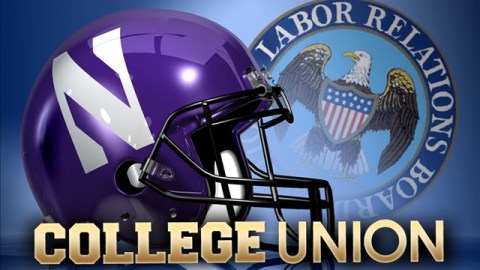The Scholar-Athlete Becomes a Unionized Employee

A regional division of the NLRB has ruled that Northwestern’s football players are more like employees of the university than students. So they are entitled to unionize and bargain collectively for pay, working conditions, and so forth.
That decision, of course, is based on a correct assessment of the facts. Big-time sports use the players for big-time profit. Not only that, everyone know their lives as students are subordinated to what they are required to do to contribute to that profit. The profit, of course, is both direct and indirect. There’s the money that flows in from tickets, TV, and the sale of merchandise. There are also donations from alumni and other supporter and the enrollment surge that can come from the team’s high-publicized success.
Tom Wolfe, in his provocative I Am Charlotte Simmons, only exaggerates when he displays top-level Division I basketball as slavery. The players know, to begin with, that they’re not at college to benefit from the moral and intellectual liberation that might come from a genuinely higher education. And little to no thought is given to whether they have the interest or aptitude to benefit from what college offers to students. Their interest and aptitude are facilitated only to the extent that they must stay in school in order to play. And staying in school these days is pretty darn easy.
The NLRB decision can be understood is part of the progress in liberating the players from slavery. The first step was freeing them from the requirement that they must stay in school for four years before turning pro. The best players now leave college–sometimes only after a year–as soon as their market value reaches a sufficiently impressive level. To choose to stay in school, after all, opens them to career-ending injuries that would keep them from cashing in at all on their talent and hard work. This new birth of freedom, of course, was good for the players, but it quickly made college basketball a lot less interesting. It should have done more than it did to free fans from the illusion that the team has anything to do with the school as an educational institution.
James Piereson speculates on how unionization will transform college athletics if this decision holds up. At first glance, the complete separation of the team from the educational program would be progress for both the players and the school. The players would finally get paid what they’re worth, and the corruption inevitably comes to our universities through compromising academic standards for profitable success on the field would disappear.
But it’s also true that most Division I football and basketball players never make it to the pros. In the worst cases, surely they benefit from some exposure to the world of higher education. In the best cases, they actually graduate from college and have opportunities outside of athletics that never would have come their way otherwise. And I can’t help but think that the coaches will become more ruthless if they are liberated from the constraints of the institution’s educational mission.
Or maybe not, because it will be easier for players to walk and play elsewhere. And the coaches will have to contend with the union. That might mean that college basketball will become as undisciplined and, well, boring as that now played in the NBA. Or it might mean that the SEC, located as it is in southern right-to-work states, might become more even more dominant in college football. “Look for the union label” in your team’s jersey might not catch on.
That reminds us, of course, that what’s most admirable about college athletics is the pure meritocracy of talent and virtue that prevails on the court or field. And we can’t help but think that such displays of excellence shouldn’t be distorted by either profit or unions–or even, to tell the truth, academic administrators and professors.
At the other extreme, we find Division III or non-scholarship athletics. At that low level, college athletics–especially but far from only football–exist as a kind of amenity offered to prospective students. If you come to our school, they’re told, you can continue to play your sport on our dime. Well, far from completely on our dime, because you’ll have to pay tuition and such just like all the other students. But still on our dime (or million), because fielding any college team is expensive and any football team really expensive. The point of the highly subsidized competition is primarily your self-fulfillment and not profit or publicity for either the institution or you.
Well, at some D-III schools the alumni do pony up to keep athletic traditions they remember with nostalgia going. But that doesn’t explain why so many colleges, especially in the South, have recently added relatively low-level football and other sports. At this low level, sports are increasingly a recruitment device to keep the academic program afloat by keeping the classrooms full. It’s a matter of controversy how much and in what way the increase in the percentage of intercollegiate athletes in the classroom affects the quality of academic programs. The truth seem to vary a lot from place to place.




